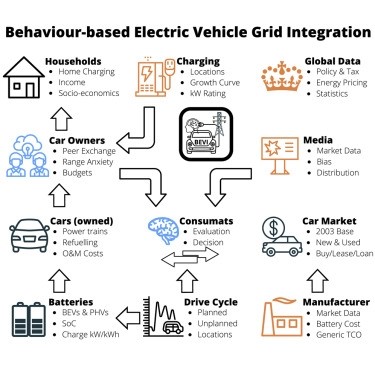Empowering the EV Community: A Comprehensive Solution for Electric Vehicle Charging
Main Article Content
Abstract
The rapid transition from conventional vehicles to electric vehicles (EVs) has created a significant demand for electric vehicle charging infrastructure. The availability of adequate EV charging infrastructure is crucial to meet this demand and support the widespread adoption of EVs. However, EV users often face challenges in accessing information about EV charging infrastructure providers, limiting their ability to plan longer journeys effectively. In response to this issue, this research paper presents a proposed web application that aims to connect EV users and enable them to assume dual roles as both service providers and service users. The web application offers interactive maps for tracking travel and destinations, facilitates user matching based on specific requirements, and provides information on payment methods and charging rates for available chargers according to their locations. By bridging the information gap and promoting communication within the EV community, this research seeks to empower EV users and foster the growth of the electric vehicle ecosystem. The comprehensive platform provided by the proposed web application is intended to facilitate information exchange, enhance user experiences, and further encourage the widespread adoption of electric vehicles.
Article Details
References
Sierzchula, W., Bakker, S., Maat, K., & van Wee, B. (2014). The influence of financial incentives and other socio-economic factors on electric vehicle adoption. Energy Policy, 68, 183-194. DOI: 10.1016/j.enpol.2014.01.043.
Zhang, T., Gensler, S., & Garcia, R. (2017). A Study of the diffusion of alternative fuel vehicles: An agent-based modelling approach. Journal of Product Innovation Management, 34(2), 137-153. DOI: 10.1111/jpim.12348.
Gnann, T., Plötz, P., Kühn, A., & Wietschel, M. (2018). Modelling market diffusion of electric vehicles with real world driving data: German market and policy options. Transportation Research Part A: Policy and Practice, 77, 95-112. DOI: 10.1016/j.tra.2015.04.013.
Gong, J., Zhou, W., & Wang, Z. (2019). Mapping electric vehicle charging serviceability: A distance constrained maximal covering location problem method. Transportation Research Part D: Transport and Environment, 70, 18-30. DOI: 10.1016/j.trd.2019.02.009.
Pearre, N.S., Kempton, W., Guensler, R.L., & Elango, V.V. (2011). Electric vehicles: How much range is required for a day’s driving? Transportation Research Part C: Emerging Technologies, 19(6), 1171-1184. DOI: 10.1016/j.trc.2010.12.010.
Jang Bahadur Saini, D. . (2022). Pre-Processing Based Wavelets Neural Network for Removing Artifacts in EEG Data. Research Journal of Computer Systems and Engineering, 3(1), 43–47. Retrieved from https://technicaljournals.org/RJCSE/index.php/journal/article/view/40
Neaimeh, M., Salisbury, S. D., Hill, G. A., Blythe, P. T., Scoffield, D. R., & Francfort, J. E. (2017). Analysing the usage and evidencing the importance of fast chargers for the adoption of battery electric vehicles. Energy, 123, 451-463. DOI: 10.1016/j.energy.2017.01.144.
Caperello, N., & Kurani, K. S. (2012). Households' stories of their encounters with a plug-in hybrid electric vehicle. Environment and Behavior, 44(4), 493-508. DOI: 10.1177/0013916511402066.
Frade, I., Ribeiro, A., Gonçalves, G., & Antunes, A. P. (2011). Optimal location of charging stations for electric vehicles in a neighborhood in Lisbon, Portugal. Transportation Research Record, 2252(1), 91-98. DOI: 10.3141/2252-11.
Helveston, J. P., Liu, Y., Feit, E. M., Fuchs, E., Klampfl, E., & Michalek, J. J. (2015). Will subsidies drive electric vehicle adoption? Measuring consumer preferences in the US and China. Transportation Research Part A: Policy and Practice, 73, 96-112. DOI: 10.1016/j.tra.2015.01.002.
Mock, P., & Yang, Z. (2014). Driving electrification: A global comparison of fiscal incentive policy for electric vehicles. International Council on Clean Transportation.
Egbue, O., & Long, S. (2012). Barriers to widespread adoption of electric vehicles: An analysis of consumer attitudes and perceptions. Energy Policy, 48, 717-729. DOI: 10.1016/j.enpol.2012.06.009.

